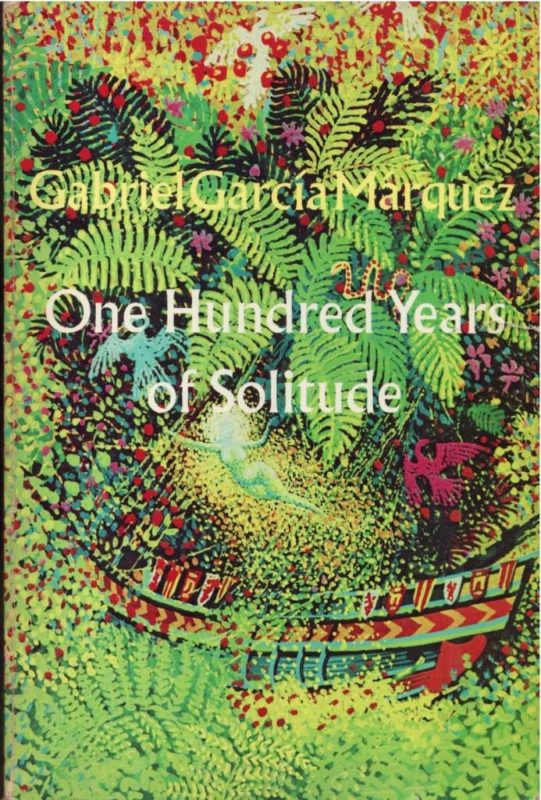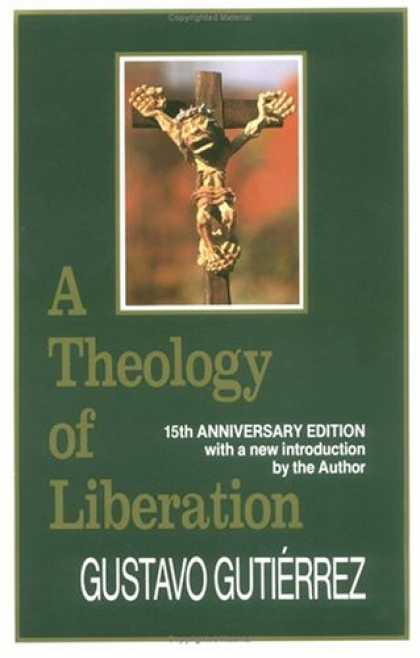Editor's Note
This guest post comes from intellectual and gender historian Lilian Calles Barger. Barger further explores the themes in this essay in her book The World Come of Age: An Intellectual History of Liberation Theology, Oxford University Press, 2018, and related posts can be found here and here. She is currently researching the history of feminist thought and the gender revolution. @lilianbarger
— Anthony Chaney
 The Colombian Nobel Laureate Gabriel García Márquez observed at the end of his literary career, “What matters in life is not what happens to you but what you remember and how you remember it.” The idea was woven into his 1967 novel Cien años de solidad [One Hundred Years of Solitude],
The Colombian Nobel Laureate Gabriel García Márquez observed at the end of his literary career, “What matters in life is not what happens to you but what you remember and how you remember it.” The idea was woven into his 1967 novel Cien años de solidad [One Hundred Years of Solitude],
which entered the world stage as part of the internationally recognized Latin American literary boom. For most of Latin America’s modern history, literary figures served as not only public intellectuals but also its political conscience. In that tradition, García Márquez offered an allegorical retelling of the history of the continent through the Edenic town of Macondo and generations of the Buendía family. The past hangs as a mist over the town, a microcosm of Latin America, where “… time was not passing … it was turning in a circle …” and the characters relive forgotten events. García Márquez’ theme of remembering and forgetting offers a rewriting of history from below, a viewpoint of how ordinary people experienced that past. Featuring fantastical descriptions characteristic of magical realism, a genre he made famous, the novel is deeply perceptive yet has a certain mischievous and ironic innocence. The book was in the stream of an intellectual movement precipitated by the shock waves of the Cuban Revolution. Intellectuals were renewing their commitment to freeing Latin America’s imagination, and its future possibilities, from U.S. neocolonialism.[1]
The Uruguayan journalist Eduardo Hughes Galeano joined the fray with his 1971 revisionist history Las venas abiertas de América Latina [The Open Veins of Latin America: Five Centuries of the Pillage of the Continent], which laid out the complaint against the U.S. The book is a must-read for every American. Galeano described the global position of the continent:
“Along the way we have even lost the right to call ourselves Americans, although the Haitians and the Cubans appeared in history as new people a century before the Mayflower pilgrims settled on the Plymouth coast. For the world today, America is just the United States; the region we inhabit is a sub-America, a second-class America of nebulous identity.”
This second-class America, what Cuban writer José Martí called “Our America,” was created through U.S. political and cultural dominance that goes back further than the ideology of Manifest Destiny, which extended not only west but also south. The dysfunctional relationship between the two Americas was the fruit of liberal hemispheric elites’ grand experiment to create modern societies out of resistant heterogeneous peoples. The 1959 Cuban Revolution unleashed centuries of resentment. In response, the U.S. bore down on dissent, propping up right-wing dictatorships. The result proved disastrous for trans-American relations.[2]
Modernization theory dominated U.S. policy at mid-century. Experts proposed that relieving pervasive poverty and safeguarding the continent against Marxism required breaking the traditional communalism. Free markets and globalized capitalism were the remedy. It was a tone-deaf imperialism. Latin American resistance to U.S. policies was fierce, as revolutionary movements spread throughout the region. It was in engagements with radical movements of the 1960s and 1970s that liberation theology emerged.
A broad swath of Latin American intellectuals rejected modernization theory, offering their own explanation for poverty-stricken shantytowns, disease, and illiteracy. The cause was “structural dependency” enforced through the machinery of global capitalism that exploited the continent’s resources and labor. Dependency was a feature, not a bug, and justified first by the Catholic Church, and later by Protestant-inspired liberalism. Radicalized theologians, Catholics and Protestants, who had trained in the U.S. and Europe moved to offer a new theological paradigm of liberation congruent with the revolutionary desire to throw off the shackles of the U.S. and its civilizing mission.[3]
Dependency theory was useful for interrogating a theology of neocolonialism and building a theology of liberation. Liberation meant not only freedom from political and economic domination but also the emancipation of the cultural imagination in which religion was not the least of the problems. The Argentine liberation philosopher Enrique Dussel identified the situation in Latin America as “pedagogical domination” of the “analytical horizon” by the world’s power center. The answer was cultivating an indigenous “barbarian philosophy” that decolonized the mind and placed Latin America in a position of epistemological privilege. An indigenous philosophy repudiated modern categories of sacred and profane, of developed and underdeveloped. It rejected the defined opposition between capitalism and communism of the Cold War. The prospects of newly situated knowledge promised to decolonize the “fetishist religion” of neocolonialism.[4]
 Caught in the wake of political unrest and intellectual resistance, theologians recognized that only a reimagined religion could contribute to liberation. The Brazilian theologian Hugo Assmann asserted the need to eradicate the “parasitic theology” of affluent nations from the minds of colonized people. Latin America had to go through a “detoxification” from North American ideological religion that served only the rich and powerful. The liberation theologians rejected modern theology’s pretense of political neutrality in the face of suffering. Theologians could not disengage; rather, they recognized the oppressed as the “avant-garde Church,” arising from below. Within the new imaginative horizon, the Peruvian Gustavo Gutiérrez’ groundbreaking 1971 book Teología de la liberación [A Theology of Liberation] led his peers into the possibility of a “permanent cultural revolution” of a “new humanity” for Latin America.[5]
Caught in the wake of political unrest and intellectual resistance, theologians recognized that only a reimagined religion could contribute to liberation. The Brazilian theologian Hugo Assmann asserted the need to eradicate the “parasitic theology” of affluent nations from the minds of colonized people. Latin America had to go through a “detoxification” from North American ideological religion that served only the rich and powerful. The liberation theologians rejected modern theology’s pretense of political neutrality in the face of suffering. Theologians could not disengage; rather, they recognized the oppressed as the “avant-garde Church,” arising from below. Within the new imaginative horizon, the Peruvian Gustavo Gutiérrez’ groundbreaking 1971 book Teología de la liberación [A Theology of Liberation] led his peers into the possibility of a “permanent cultural revolution” of a “new humanity” for Latin America.[5]
Liberationists viewed the continent as trapped in the past, like García Márquez’s little town of Macondo. Only by repudiating the past could Latin America enter into the divine unfolding future. In this sense, they were thoroughly Hegelian. The future would come through the poor with an awakened political consciousness, free from a mystifying transcendent God. Instead, the poor of Latin America would embrace a God committed to their liberation. As Gutiérrez asserted, “To conceive of history as a process of human liberation is to consider freedom a historical conquest; it is to understand that the step from an abstract freedom to a real freedom is not taken without a struggle against all the forces that oppose humankind.” God joined in the liberation of the oppressed, not in an otherworldly salvation, but situated in the politics of this world.[6]
Liberation theologians’ rejection of modernization theory and their solidarity with revolutionary groups did not endear them to U.S. religious leaders and policymakers. They deemed the effort to recognize the political agency of the poor as Marxist, as utopian, and as a dangerous politicization of religion. Moving with U.S. black and feminist theologians, Latin Americans incited a global awakening to the political force of the American religious mission and offered post-colonial people the means to free themselves from an imperial imagination and its religion.
_________
[1] Gabriel García Márquez, Living to Tell the Tale ( NY, NY: Knopf, 2003) Epigraph. García Márquez, One Hundred Years of Solitude (New York, NY: Perennial Classics, 1998), 361.
[2] Eduardo Galeano, Open Veins of Latin America: Five Centuries of the Pillage of a Continent
(New York: Monthly Review Press, 1973), 2.
[3] Fernando Henrique Cardoso and Enzo Faletto, Dependency and Development in Latin America, (Berkeley, CA: University of California Press, 1979), xiv.
[4] Enrique Dussel, A History of the Church in Latin America: Colonialism to Liberation, 1492-1979 (Grand Rapids, MI: William B. Eerdmans, 1981), 5: Dussel, Filosophia de la liberacion (Mexico: Ediotrial Edicol, 1977) 14-15, 95-97.
[5] Hugo Assmann, Theology for a Nomad Church (Maryknoll, NY: Orbis Books, 1975), 56, 94; Gustavo Gutierrez, A Theology of Liberation (Maryknoll, NY: Orbis Books, 1971), 21, 81.
[6] Gutierrez, A Theology of Liberation,10.

2 Thoughts on this Post
S-USIH Comment Policy
We ask that those who participate in the discussions generated in the Comments section do so with the same decorum as they would in any other academic setting or context. Since the USIH bloggers write under our real names, we would prefer that our commenters also identify themselves by their real name. As our primary goal is to stimulate and engage in fruitful and productive discussion, ad hominem attacks (personal or professional), unnecessary insults, and/or mean-spiritedness have no place in the USIH Blog’s Comments section. Therefore, we reserve the right to remove any comments that contain any of the above and/or are not intended to further the discussion of the topic of the post. We welcome suggestions for corrections to any of our posts. As the official blog of the Society of US Intellectual History, we hope to foster a diverse community of scholars and readers who engage with one another in discussions of US intellectual history, broadly understood.
Thanks for this, Lilian! I’m slowly reading your book, during my train commute (currently on p. 89). The actors in your post above are all already familiar to me. Anyway, looking forward to having more informed opinions about a topic (liberation theology) that I long shunned and neglected. – TL
Tim, Thank you. Nothing to be scared up rather liberation theology is very eye-opening about so much. The Right seized the narrative early. Cheers.